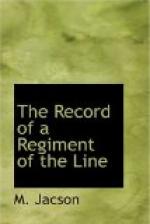The chief cause of attraction and interest in the bridge to outsiders was the fact that it had been constructed entirely by British infantry without the aid of the Royal Engineers, and that the plan had been thought out by them alone, and was not “in the book.” The idea had been taken from some photographs of a Cashmere “jhula,” and the work had been carried out from descriptions of the rope bridges furnished by an officer of the Regiment who had crossed them. All previous bridges had been washed away, but this bridge was still standing at the end of the war, and was being utilized then by the Kaffirs at Mission Camp as an easy access and short cut to their cultivated fields.
On January 12th, as a larger convoy than usual was coming through to Lydenburg, a small force under Captain Jacson, consisting of two companies Devons, one company mounted infantry and one gun went out from Mission Camp to demonstrate towards Schoeman’s Laager on the west. No Boers, however, were seen, and the convoy came safely into Lydenburg without opposition.
Several changes occurred in the disposition of the companies of the Regiment during the latter half of January, 1901.
The head-quarters with three companies were stationed at Witklip under Colonel Park. Two companies proceeded to Badfontein as a garrison under Major Davies. One company held each of the posts at Bridge Hill and Paardeplaats respectively. One company was in charge of the Mission House, whilst one company was left at Mission Camp to commence the construction of a new work south of the old camp.
[Illustration: Wire Bridge, Lydenburg (General Kitchener and Colonel Park)]
These changes were made on account of some large convoys going and coming to and from the railway line, larger escorts having to be provided owing to the proximity and increased activity of the Boers on the lines of communication. The convoys came through safely without any trouble, and on January 30th Major Davies with his two companies returned to Witklip. The head-quarters of the Regiment, with three companies, left Witklip the following day and proceeded to Mission Camp. Further changes were made during February, 1901, the post at Paardeplaats being given up and the company posted there returning to Mission Camp.
Towards the latter end of January a flying column was organized by General Walter Kitchener. The objective of this column was the high hills south of Lydenburg towards Witpoort and Belfast. It was under the personal command of the General, and was composed of the following troops:—
1 squadron 19th Hussars. 1 battery R.F.A. 1 naval 12-pounder. 1 pompom. 1 company Manchester Mounted Infantry. 3 companies Devons under Captain Travers.




